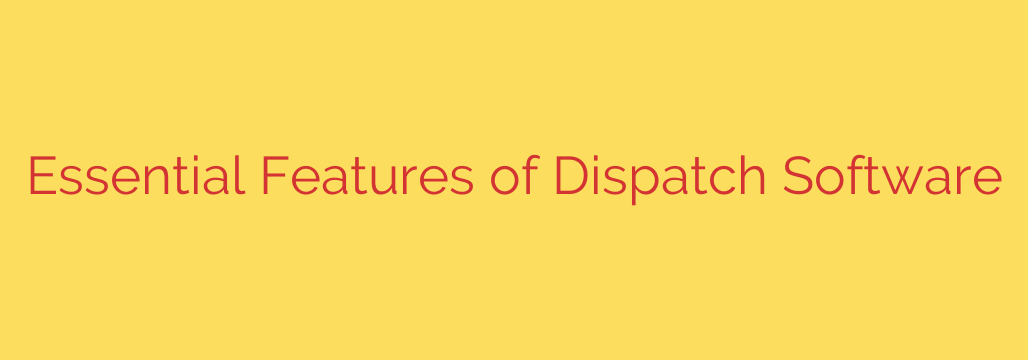
Boost Your Fleet’s Efficiency: 7 Essential Features Your Dispatch Software Needs
Managing a mobile workforce can feel like conducting a chaotic orchestra. Juggling phone calls, deciphering messy paperwork, and providing vague ETAs to customers can quickly drain resources and damage your reputation. In today’s competitive landscape, relying on manual processes is no longer a viable option. Modern dispatch software is the key to streamlining your operations, cutting costs, and delivering superior service.
However, not all dispatch platforms are created equal. To truly transform your business, you need a solution packed with powerful, intuitive features. When evaluating your options, prioritize these seven essential components to ensure you’re making a smart investment.
1. Real-Time GPS Tracking and Visibility
Knowing where your assets are is the foundation of effective dispatching. Gone are the days of calling drivers for their location. Modern software must offer a live map that provides a bird’s-eye view of your entire fleet in real-time.
This is critical for:
- Providing accurate ETAs to customers, significantly improving their experience.
- Improving driver safety and accountability by monitoring speed and location history.
- Making smarter dispatch decisions by assigning the closest available technician to an urgent job.
Look for a system that provides not just location but also trip history, idle time, and speed alerts.
2. Intelligent Route Optimization
Simply mapping a route from point A to point B isn’t enough. True efficiency comes from intelligent route optimization, which calculates the most efficient multi-stop routes for your entire team. This sophisticated feature should account for variables like traffic patterns, vehicle capacity, driver schedules, and customer time windows.
The result? Significant reductions in fuel consumption, labor hours, and vehicle wear and tear. By cutting down on drive time, your team can complete more jobs per day, directly boosting your bottom line.
3. Automated Scheduling and Job Assignment
Manual scheduling is time-consuming and prone to human error. Top-tier dispatch software automates this process. You should be able to create jobs, set priorities, and let the system recommend the best technician based on predefined rules.
Look for software that can assign tasks based on skill set, availability, location, and even vehicle inventory. This automation frees up your dispatchers to focus on handling exceptions and providing high-level customer service instead of getting bogged down in logistical puzzles.
4. Seamless Two-Way Communication
Clear, centralized communication is non-negotiable. Relying on a mix of personal text messages, phone calls, and emails creates confusion and leaves no official record. A robust dispatch platform includes a built-in messaging hub.
This allows dispatchers and field staff to communicate directly within the app. They can share job updates, upload documents, and report issues instantly. This creates a permanent, time-stamped record of all job-related communication, which is invaluable for resolving disputes and ensuring everyone is on the same page.
5. A User-Friendly Mobile App for Field Staff
The most powerful software in the office is useless if your team in the field can’t or won’t use it. An intuitive and easy-to-use mobile app is absolutely essential. Your technicians and drivers need to be able to view their daily schedules, access job details, navigate to their next stop, and update job statuses with just a few taps.
A clunky, complicated app will lead to poor adoption and inaccurate data. When vetting software, always ask for a demo of the mobile app to ensure it’s designed for the people who will use it most.
6. Digital Proof of Service or Delivery (PoD)
Disputes about whether a service was completed or a package was delivered can be costly and time-consuming. Modern dispatch software eliminates this ambiguity with digital proof of service features.
Through the mobile app, your field staff can capture:
- Customer signatures
- Photos of the completed work or delivered item
- Notes and custom forms
This digital evidence is instantly uploaded and attached to the job record, protecting your business from false claims and speeding up the invoicing process.
7. Robust Reporting and Analytics
You can’t improve what you don’t measure. The best dispatch software is also a powerful business intelligence tool. It should automatically collect data and present it in easy-to-understand reports and dashboards.
Look for the ability to track key performance indicators (KPIs) like:
- On-time performance
- Jobs completed per day
- Average time on-site
- Total mileage and fuel usage
These insights allow you to identify top performers, pinpoint operational inefficiencies, and make data-driven decisions to continuously improve your business.
By ensuring your chosen dispatch software includes these seven core features, you are not just buying a tool—you are investing in a more efficient, profitable, and customer-focused future for your operation.
Source: https://kifarunix.com/qualities-to-look-for-in-a-good-dispatch-software/








